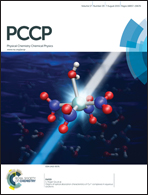Intra-molecular magnetic exchange interaction in the tripyridinium bis[tetrachloroferrate(iii)] chloride molecular magnet: a broken symmetry-DFT study†
Abstract
The investigation of magnetic ordering in magnetic molecular conductors is the subject of ongoing research studies in the fields of condensed matter physics, chemistry and material sciences. Following the photo-magnetic behavior already observed in individual (FeCl4)2(py·H)3Cl molecules at room temperature, magnetic ordering is studied in this work. Calculations are performed using spin projected broken symmetry via density functional theory within the scheme of the B3LYP approximation. The value of the intra-molecular magnetic coupling constant is obtained as J = 13.2062 kJ mol−1. A field dependent magnetization experiment is conducted to validate the magnitude and the sign of the exchange constant. Reasonable consistency of experimental and theoretical results confirms the presence of a positive intra-molecular indirect exchange interaction. This work paves the way for possible introduction of a new molecule in the development of advanced molecular electronic devices.
![Graphical abstract: Intra-molecular magnetic exchange interaction in the tripyridinium bis[tetrachloroferrate(iii)] chloride molecular magnet: a broken symmetry-DFT study](/en/Image/Get?imageInfo.ImageType=GA&imageInfo.ImageIdentifier.ManuscriptID=C5CP02770E&imageInfo.ImageIdentifier.Year=2015)

 Please wait while we load your content...
Please wait while we load your content...